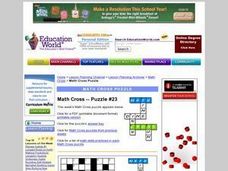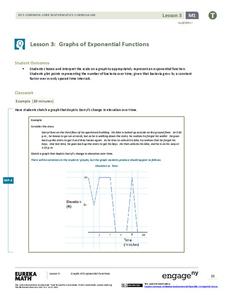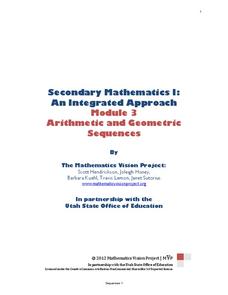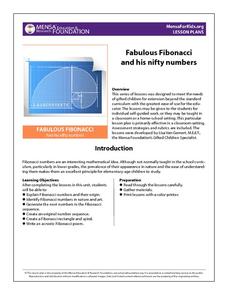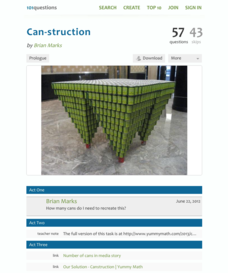Curated OER
Algebra: Sequences and Patterns
In this patterns instructional activity, students read the four steps to find the next three terms in a math sequence. Students find the pattern and write the next three terms in 13 problems.
Curated OER
Problem-Solving Strategy: Find a Pattern
In this tessellations worksheet, students solve 2 word problems where they use the "make a pattern strategy" to form tessellations from geometric shapes. There is scaffolding for the problem solving strategy.
Curated OER
A Matter of Pattern
Students explore how shapes can make patterns then make connections as to how elements in a pattern relate to one another. In this matter of pattern instructional activity, students create a multi-folded paper snowflake. Students engage...
Curated OER
The Beauty of Number Patterns
Teaching your child about patterns can be a fun and motivating experience.
Curated OER
Complete the Patterns
In this pattern completion worksheet, students observe groups of six patterns and add the final two patterns. Students complete five sets of patterns.
Curated OER
Exploring Number Patterns to Discover Common Factors
Young scholars listen and watch a video to see a drummer beat and find a pattern, while learning about the least common factor. In this lesson, the concept of least common factors is being taught through the use of musical instruments,...
Curated OER
Writing Equations From Patterns
In this writing equations worksheet, 9th graders solve and complete 6 different problems that include various patterns. First, they read and identify relations of equations and the difference between successive values of x and y. Then,...
Curated OER
Math Cross Puzzle #20
For this math puzzle worksheet, students solve 28 problems and insert the answers into a puzzle grid. The problems include all 4 math operations, telling time, measurement, word problems, rounding, money and math patterns. Answers will...
Curated OER
Math Cross Puzzle #23
For this math puzzle worksheet, students solve 28 problems and insert the answers into a puzzle grid. The problems include all 4 math operations, telling time, measurement, word problems, rounding, money and math patterns. Answers will...
Curated OER
Math Cross Puzzle #34
In this math puzzle instructional activity, students solve 28 problems and insert the answers into a puzzle grid. The problems include all 4 math operations, telling time, measurement, word problems, rounding, money and math patterns....
Curated OER
Math Cross Puzzle
In this math puzzle worksheet, students solve 25 problems and insert the answers into a puzzle grid. The problems include all 4 math operations, telling time, measurement, word problems, rounding, money and math patterns. Answers will be...
Curated OER
Matchstick Math: Using Manipulatives to Model Linear, Quadratic, and Exponential Functions
Playing with matches (unlit, of course) becomes an engaging learning experience in this fun instructional unit. Teach pupils how to apply properties of exponential functions to solve problems. They differentiate between quadratic and...
EngageNY
Dividing by (x – a) and (x + a)
Patterns in math emerge from seemingly random places. Learners explore the patterns for factoring the sum and differences of perfect roots. Analyzing these patterns helps young mathematicians develop the polynomial identities.
Curated OER
Pencil It In
In this recognizing patterns learning exercise, students identify problems with patterns and draw the number of pencils that most likely come next. Students solve four problems.
Curated OER
Number Patterns
Help your students to identify even and odd numbers. For this number sense lesson, they read the book Madeline and use counters to identify which number has a "partner." Learners write down odd and even numbers on a whiteboard.
EngageNY
Graphs of Exponential Functions
What does an exponential pattern look like in real life? After viewing a video of the population growth of bacteria, learners use the real-life scenario to collect data and graph the result. Their conclusion should be a new type of graph...
EngageNY
Why Do Banks Pay YOU to Provide Their Services?
How does a bank make money? That is the question at the based of a lesson that explores the methods banks use to calculate interest. Groups compare the linear simple interest pattern with the exponential compound interest pattern.
National Council of Teachers of Mathematics
Math Challenge #23: Fractals
Young scholars explore the concepts of Sierpinski's triangle, ratios, and concentrations. In this exploratory lesson, students are given three problems to solve. Young scholars learn about Sierpinski's triangle, how to calculate mpg for...
Mathematics Vision Project
Module 3: Arithmetic and Geometric Sequences
Natural human interest in patterns and algebraic study of function notation are linked in this introductory unit on the properties of sequences. Once presented with a pattern or situation, the class works through how to justify...
MENSA Education & Research Foundation
Fabulous Fibonacci and His Nifty Numbers
Fibonacci numbers are not only found in the classroom but also in nature. Explore the concept of Fibonacci numbers through a series of lessons designed to gain insight into the mathematical reasoning behind the number pattern, and spark...
Balanced Assessment
Number Game
It's all in the numbers! Create a mathematical model to analyze a number game and develop a winning strategy. Using a given numerical pattern, scholars write an expression to model the scenario. They then interpret the pattern of the...
101 Questions
Can-struction
Can you solve it?! A New York City art challenge involves making sculptures from cans. The task is to determine the number of cans used in the engineering award-winning sculpture. Scholars consider the patterns in the different layers to...
Bowland
Patchwork Cushions
Find out if there are enough squares. Given diagrams for the first four figures in a sequence, pupils try to determine the next figure. Individuals find the number of square and triangle pieces of fabric that are required to make...
Mathematics Assessment Project
“Ponzi” Pyramid Schemes
Use mathematics to show your classes the power of a good model. Young mathematicians analyze the famous Ponzi pyramid scheme using an exponential pattern. They make conclusions on the reliability of the plan and why it is illegal.
Other popular searches
- Patterns in Math
- Elementary Math Patterns
- 100th Day Math Patterns
- Farm Animal Math Patterns
- Growing Patterns in Math
- Powerpoint Math Patterns
- Growing Patterns Math
- Math Patterns and Rules
- Math Patterns and Relations
- Number Patterns in Math
- Geometric Patterns in Math
- Inauguration Math Patterns










